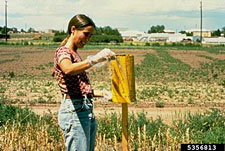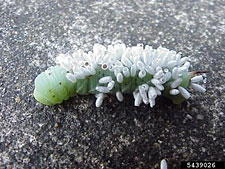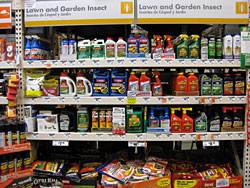Introduction
Most effective insect management plans include one or more management strategies. Applying IPM strategies, insect control can be split into five separate categories.
Prevention

Photo credit: Scott Bauer
USDA Agricultural Research Service, Bugwood.org
Prevention includes such practices as using pest-free plant stock and materials. Prevention also includes removing insect pests before they can lay eggs or become carry disease.
Inspect plants regularly so you can catch insect pests before they reproduce.
Cultural Controls
Cultural controls are management practices that reduce the incidence of insect infestations, such as proper planting times and planting rates, planting companion crops, managing fertilization and irrigation to favor desired plants rather than insect pests, rotating crops, and planting cover crops or trap crops. Good sanitation, including manure management plans, will help reduce insect pest infestations, such as cockroaches and flies. Changing the environment to discourage insect pests by controlling temperature, light or humidity is another cultural control method.
Mechanical/Physical controls
 Photo credit: William M. Brown Jr., Bugwood.org
Photo credit: William M. Brown Jr., Bugwood.org
These include hand-picking insects and the use of barriers, such as row covers. They also involve using mechanical devices that disrupt the soil and make conditions unsuitable for the survival of insect pests. Other mechanical controls include installing physical barriers, such as window screens and sealing cracks, to exclude insect pests, or trapping insect pests (for instance, with sticky traps).
Biological controls

This tomato hornworm has been attacked by
parasitic wasps, a type of beneficial insect.
Photo credit: Chazz Hesselein
Alabama Cooperative Extension System, Bugwood.org
Biological control is the use of a living organism to control insect pests. Success depends upon selectivity, reproduction, adaptation and ability of the organism to reach a high level of effectiveness. Predator or parasitic insects that target other insects are a good example. Generally, biological controls will not eradicate the pest, but they will help reduce the pest population to a manageable level. Care must be used to avoid damaging the biological control insect by using an incompatible chemical control (an insecticide).
Chemical controls
Chemical control uses pesticides, or more specifically, insecticides to control a target insect pest. Many insecticides are available. Read the label carefully and know how they are used and how they work before you apply them.

There are many products available to control insects. Be sure to read
the label carefully before using to ensure the correct product is used
in the right way, and you and others are protected.
Photo credit: University of Nevada, Reno Extension
- Selective insecticides: Chemicals that kill a specific type of insect pest or target a specific life cycle of the pest.
- Nonselective insecticides: Chemicals that kill all insects, pest or beneficial.
- Contact insecticides: Chemicals that kill the insect pest only where the chemical touches the pest or a site the pest frequents. They require thorough coverage and are quick- acting, but they must come into contact with the pest to be effective.
- Systemic insecticides: Chemicals that are absorbed by the plant or animal which the insects are attacking. When the insects feed on the plant or animal, they ingest the insecticide and die. Systemic insecticides take time to be effective. They may be applied to the soil or foliage of plants and then eaten, or applied as a surface treatment for animals, such as flea treatments.
Hefner, M.
2019,
Insect Management,
Extension | University of Nevada, Reno. IP


